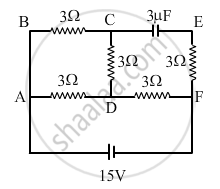Advertisements
Advertisements
प्रश्न
Suppose there is a circuit consisting of only resistances and batteries and we have to double (or increase it to n-times) all voltages and all resistances. Show that currents are unaltered. Do this for circuit of Example 3.7 in the NCERT Text Book for Class XII.
उत्तर
Let us first assume the equivalent internal resistance of the battery is Reff, the equivalent external resistance R and the equivalent voltage of the battery is Veff.
Now by applying Ohm's law,
Then current through R is given by `I = (V_"eff")/(R_"eff" + R)`

Now according to the question if all the resistances and the effective voltage are increased n-times, then we have
`V_("eff")^("new") = nV_("eff"), R_("eff")^("new") = nR_("eff")`
And Rnew = nR
Then, the new current is given by
`I^' = (nV_("eff"))/(nR_("eff") + nR) = (n(V_("eff")))/(n(R_("eff") + R)) = ((V_("eff")))/((R_("eff") + R)) = I`
The last result of two equations is same, so we can say that current remains the same.
APPEARS IN
संबंधित प्रश्न
An electric bulb draws 1.2 A current at 6.0 V. Find the resistance of filament of bulb while glowing.
In the circuit shown in the figure, find the total resistance of the circuit and the current in the arm AD.

State and define Ohm’s law.
Define ampere and volt with respect to Ohm’s law.
Choose the correct alternative.
Which of the following is an ohmic conductor?
Define temperature coefficient of resistance.
An electronics hobbyist is building a radio which requires 150 Ω in her circuit, but she has only 220 Ω, 79 Ω, and 92 Ω resistors available. How can she connect the available resistors to get the desired value of resistance?
A heater of 220 V heats a volume of water m 5 mint time. A heater of 110 V heat in ten second. The resistance of the conductor is
Consider a current carrying wire (current I) in the shape of a circle. Note that as the current progresses along the wire, the direction of j (current density) changes in an exact manner, while the current I remain unaffected. The agent that is essentially responsible for is ______.
State Ohm's Law. Represent it mathematically.
